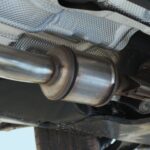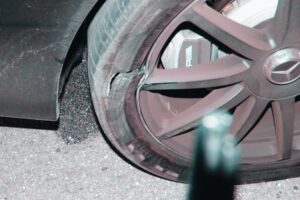While you can fix a flat tire in several ways, the best method depends on why it has gone flat. One way is to plug the tire hole because it is the fastest and the most convenient way. However, there’s one thing you need to consider: can you drive a long distance with a plugged tire?
Many studies show the safest distance you can drive with a plugged tire is 8 miles. Plugging a tire is just a temporary fix. The idea is to plug the tire to use it temporarily until you can take it for a fix at a tire service shop. If you use it longer, you risk damage not only to your tires but also to your vehicle.
Driving long distances with a plugged tire is not advisable because your car’s handling will also be affected. Eventually, the tire could blow out if you use it repeatedly. While some drivers say they have experienced driving their plugged tires at very long distances, it is still not advisable to do it.
Read on to learn whether it is safe or not to drive a plugged tire for long distances, if plugged tires are still dependable, and what the consequences will be if you do it.
Can You Drive a Long Distance With a Plugged Tire?

Based on the many studies made on this subject, the safest maximum distance you can drive if your tire is plugged in is 8 miles. Longer than that, you risk a blowout and other related vehicle issues such as handling problems, damage to certain vehicle parts, etc.
With a plugged tire, you are advised to drive it only to keep your vehicle moving until you get to a tire service shop to fix its issue. Don’t try to push a plugged tire more than 8 miles or risk more damage to the tire and your vehicle.
Some drivers say they could drive their vehicles with plugged tires for long distances. But that does not mean it is safe for you to do it.
Remember that a tire with a plugin is no longer 100% safe. Plugs won’t last forever. A plugged tire cannot withstand the same pressure and road stress as a whole tire.
Additionally, the strength of the plug in the tire depends on how efficiently and correctly it was applied to the tire hole. If the tire tech did not perform a good job plugging it, it wouldn’t hold up very long.
Can You Drive Long Distances with a Plugged Tire?
Tire plugging is just a temporary fix. Plugged tires should not be used for a long time. Tire shops and tire techs follow a specific process for plugging tires.
The degree by which the tire can be brought close to its former integrity depends on the quality of the tire plugging it receives from the tire mechanic.
If you examine the process of tire plugging, you will understand why it could be effective or not, depending on how the tire tech did their job. A tire mechanic that performs his task conscientiously will produce a stronger plugged tire than a tire tech that does his job haphazardly.
This is why you can’t say whether or not your plugged tire is safe to drive for long distances. So, will your plugged tire be safe to use for long distances? The straight answer is: it depends.
For this reason, it is not easy to tell if your plugged tires can last up to 24,000 miles or just about 10 miles. You have to be there and witness how the tire tech is doing their job before you can safely say: “yes, I think I can use this plugged tire for long-distance driving.”
Is a Tire Plug Sufficient?
Plugging a tire is the fastest way of fixing a tire hole. And that depends on how big the hole is. Large tire holes cannot be fixed by using tire plugs alone. They need to be patched, with some even requiring vulcanization to get the tires functional again.
Remember that tire plugs can’t prevent the air inside from escaping like whole and unblemished tires. They are just not 100% structurally strong. But tire plugs are the most convenient and quickest way to fix a small tire hole that causes air leaks.
Tire plugs are more convenient than tire patching or vulcanizing because you don’t have to remove the problematic tire from its wheels. You only need to apply it to the hole, and presto! The leak is stopped right away.
You should always be aware that your plugged tire is no longer structurally strong. So, be more considerate in using your plugged tire. It can go bad faster than a whole and undamaged tire. Plus, you can’t use it for your 4×4 excursions.
It just can’t withstand the stress it can take from road imperfections and debris. You will know whether the plugging performed on your tire is good.
If there are leaks from the tire, then it’s not good. However, if it keeps holding up the air inside, you can use the tire longer.
How Long Does It Take for a Tire Plug to Set?

Plugging a tire is not as complicated and laborious as patching or vulcanizing it. So, when the tire plugging process is completed, you can immediately use the tire. Vulcanizing and patching require you to dismount your tire from the wheel before you can start the fixing process.
In plugging a tire, you don’t have to remove the tire from its wheels. Just apply the tire plug, and you are done. The material of the tire plug will seek the best place it will ensconce itself inside the hole. Practically, you don’t need to do anything. The tire plug will do its work by itself.
Just ensure the glue in the plug has wholly dried before driving away. It usually takes a couple of minutes for a tire plug to seal.
Again, can you drive long distances with a plugged tire? Studies have shown you can drive up to 8 miles with a plugged tire. But fix it immediately since plugging a tire isn’t a long-term solution.
How Long Does It Take to Plug a Tire?
If everything is considered, plugging and patching a tire produces the same result. The quickness and convenience of the process make the difference between the two.
Plugging a tire more often can be accomplished in 10 to 15 minutes. The actual time depends on the size and extent of the hole.
Patching a tire takes longer because you must remove it from its wheels. That means the additional time before the actual fixing is done. And then the repair can take more time because after checking the tire, you may be required to vulcanize it.
In short, there are many stages in the process of tire patching compared to tire plugging. Tire mechanics typically spend in patching a tire is around 30 minutes. So, if it is just a tiny tire hole, a tire plug will be the quickest and most convenient way to fix it.
When Should You Plug Tires?
If your tire is flat, you can plug or patch it. Why would you choose to plug over patching your tire? You should inspect the condition of your tire to be able to see the most appropriate fix.
If the puncture or hole is on the tire tread or the middle of the tire, you can choose either of the two methods. The determining factor of what to use is the size of the hole or puncture. You will plug it if the hole is no greater than 1/4 inch.
With a hole larger than that, you have to patch it. Additionally, you should not use tire plugs for old and overused tires. The tire structure of an old tire already compromises its strength. If there’s a puncture, plugging the hole even compromises its strength.
Where Should You Not Put a Tire Plug?
Apart from the size of the puncture, the best spot to place a tire plug depends on the extent of damage the tire has been subjected to. You should only put a tire plug when the puncture is located on the tire tread and not on its sidewall or close to it.
Applying a tire plug on a hole in the tire’s sidewall is not advisable because it can alter the tire’s structure and cause a potential blowout. To repeat, you should not use tire plugs for tire punctures that are more than 1/4 inch.
When the tire is rolling, and the puncture is greater than 1/4 inch, the tire will not be able to support its structure because of the frictional pressure and weight of the vehicle.
What Is the Fastest Way to Plug a Hole in a Tire?

If you need to plug a tire into your vehicle, doing it takes only seven steps. It is not a complicated process and will only take several minutes. Here are the steps in condensed form:
1. Remove the Tire
Remove the tire. This is unnecessary if the tire puncture is located on the tire tread and is no bigger than 1/4 inch. However, no one will prevent you if you want to remove it from its wheel.
2. Remove the Object That Punctured the Tire
Remove the object that inserted itself into the tire. Use a pair of pliers to do this.
3. Insert a Rasp into the Hole
Get a rasp and insert it into the tire puncture. Use the rasp to rough the edges of the hole so the tire plug can easily attach itself.
4. Put the Tire Plug Into the Needle
A needle is a tool that you can use to attach the tire plug to the hole. It should have an eye or open end so you can remove it easily when the plug is already inside the hole.
5. Insert the Needle (With the Plug) into the Hole
Use the appropriate force to insert the needle into the hole. The rubber compound of the tire plug will expand and prevent the air inside the air from leaking out. Ensure that the plug is fully inserted. Leave about an inch of it hanging outside to be sure.
6. Remove the Excess Plug
Use a sharp cutter to cut off the excess plug outside the tire.
7. Try Out the Plug
You must test the newly installed tire plug to see if it works. Do this by spraying water in the spot where you placed it. If no bubbles are coming out of that area, you are successful in doing the job. If bubbles are present, you must redo it or ask a qualified tire mechanic to do it.
In Closing
Many studies showed that the maximum distance you can go with a plugged tire is only 8 miles.
It is just a temporary fix, so you are not advised to drive longer than that. You need to drive a plugged tire only to move your vehicle so you can bring it to a tire shop and have its issue fixed.
Using the tire farther than 8 miles is risking your safety. The tire may blow out, or you may experience handling problems unsafe for you, your passengers, and other people using the road.









